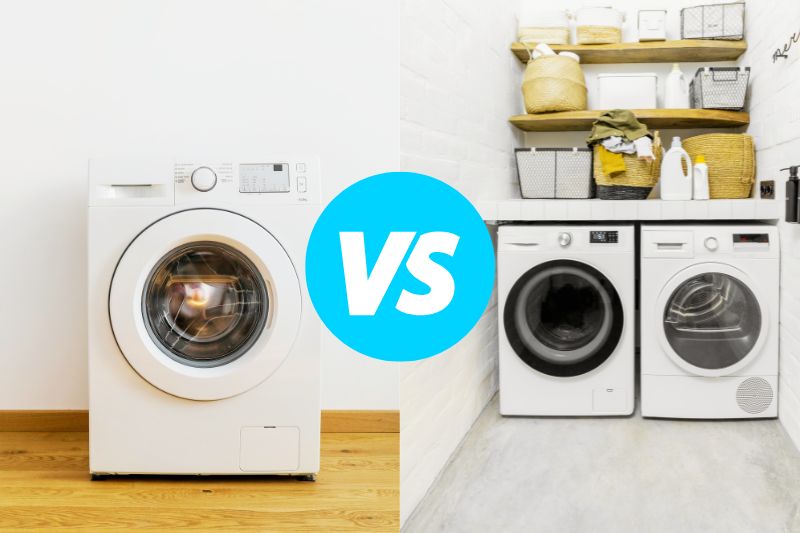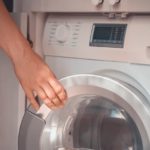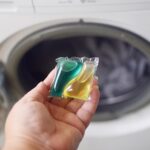When it comes to doing laundry, having efficient, hassle-free and reliable appliances is essential! After all, nobody wants to spend all day doing the washing!
One big decision that homeowners face is whether or not to buy a combined washer dryer, or separate appliances.
Both options have pros and cons, and you must assess each point before making an expensive investment!
Read on to find out what the main positives and negatives of getting a washer dryer versus a separate washing machine and tumble dryer are.
Pros and Cons of Washer Dryers
The benefits of a washer dryer
Here are the main pros of getting a washer dryer:
1. Saves space
A huge benefit of getting a washer dryer is that it doesn’t take up too much room. And it’s much easier to house one appliance rather than two in an abode!
Getting a washer dryer is a great idea if you live in a flat or a small apartment where space is limited, and you’ve got to be creative with the space you have available!
2. The financial burden can be much less with a washer dryer

Another benefit of getting a washer dryer is that it can cost you much less.
For example, if you were to buy a basic washer dryer (that didn’t come with fancy features), you’d be looking at pay around £300.
If you bought one of the cheapest, basic washing machines, as well as a cheap tumble dryer, each appliance would cost you roughly £200. It would, therefore, cost you about £400 to buy both appliances, which is £100 more than what you’d pay for a cheap washer dryer.
Of course, you can upgrade the appliances listed above so that they come with all the features you need. However, additional benefits usually mean a heftier price tag! See the example below.
Some standalone top-of-the-range washer dryers (wealth of features and better technology) can cost over £1,500 to buy. For comparison, you can buy standalone washing machines that cost £1,500 plus, as well as standalone dryers that cost the same price!
In addition to the initial outlays you’ll have to cover, you’ll also need to factor in any delivery or installation fees. Plus, you might like to take cover out on your appliance(s). These extra costs can be expensive if you have multiple appliances. But it won’t be too bad if it’s just one machine!
3. Using a washer dryer can be more convenient
It’s arguably easier to just have a washer dryer because it’s simpler to use, especially in terms of accessibility.
For example, you just load your dirty clothes into the drum, select an appropriate washing and drying cycle, and allow the machine to do the work for you.
There isn’t too much fuss involved. For example, you don’t have to move clothes from one machine to another.
4. Water can be drained from a washer dryer immediately
One bonus of getting a washer dryer is that the machine tends to be plumbed in. This means that water collected inside the appliance during the drying cycle gets drained straight away through the drain.
In contrast, some tumble dryers, like condensers, have a water reservoir that needs to be manually emptied by the user. This task isn’t too time-consuming to carry out, but it does require the user’s input.
5. You can use a washer dryer as two separate appliances

Although a washer dryer is used to wash and then dry wet laundry, you can also use the appliance’s features separately. For example, you can just wash clothes or just dry laundry in the machine.
It’s great that the machine can do this because not all clothes should be dried in a tumble dryer, so it’s good to have the option of just washing outfits.
In short, you’re not bound to washing and drying clothes all at once. You can use the machine’s functions separately!
6. Don’t need a vent
Stand-alone tumble dryers often use a vent to remove moist hot air to the outside. In comparison, washer dryers are usually ventless and use hot air to evaporate moisture through a condensing chamber. A drain hose is then used to flush extracted liquid to the plumbing system.
Because washer dryers are usually ventless, you don’t have to run a vent outside, which can give you more options for installation and positioning.
The drawbacks of a washer dryer
Here are the main cons of getting a washer dryer:
1. Washer dryers often have longer washing and drying cycles
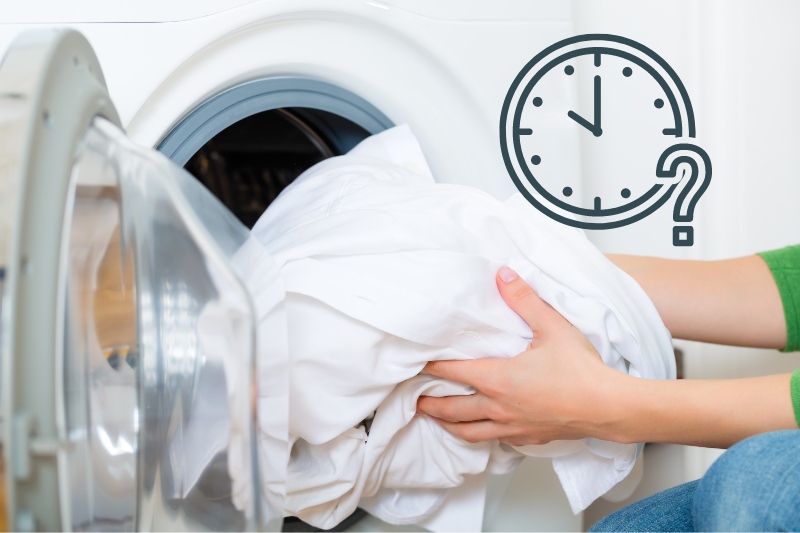
One of the many issues with getting a washer dryer is that washing and drying times can be longer.
This may not be a big issue if you don’t have lots of washing to do. But it’s not exactly practical if you live in a busy family home, where there’s a lot of washing to tackle each day.
If you live in a busy home and need to do lots of washing throughout the week, you’d have to schedule the laundry tasks in, so you’d allow yourself enough time to wash and dry your clothes effectively!
Given that you can’t dry the same amount of laundry as you’ve washed, and you may have to rinse some loads twice when using a washer dryer, you’ll have to factor in a lot of extra laundry time to deal with these little issues. (More on these points later).
2. The load capacity will be smaller for the dryer in comparison to the washer
Getting a washer dryer means you don’t have to fuss around with laundry when it’s being washed and dried, or so you might think…
There is one issue though: you can’t dry as much as you can wash in a washer dryer.
In a nutshell, your washer dryer will have two separate load capacities, one for the washing function and another for the dryer function. The figures (usually in kgs) will be entirely different.
You’ve got to stick to these different load capacities to ensure your washing is cleaned and dried properly, and to make sure you don’t put a strain on the appliance.
Take a look at the example below:
If your washer dryer has a washing capacity of 9kg, you won’t be able to dry 9kg of wet washing. You’ll have to decrease this amount to, say, about 6kg to fit with the dryer’s load capacity. By reducing the load, the dryer can effectively dry the laundry.
This means you’ll have to take some clothes out of the machine before you run the drying cycle. You’ll then have to dry the items you removed from the machine separately in a second drying cycle later on.
It’s not exactly as seamless as you’d like! And consequently, you’ll spend much longer washing and drying your laundry!
3. You’re more likely to overload a washer dryer with laundry
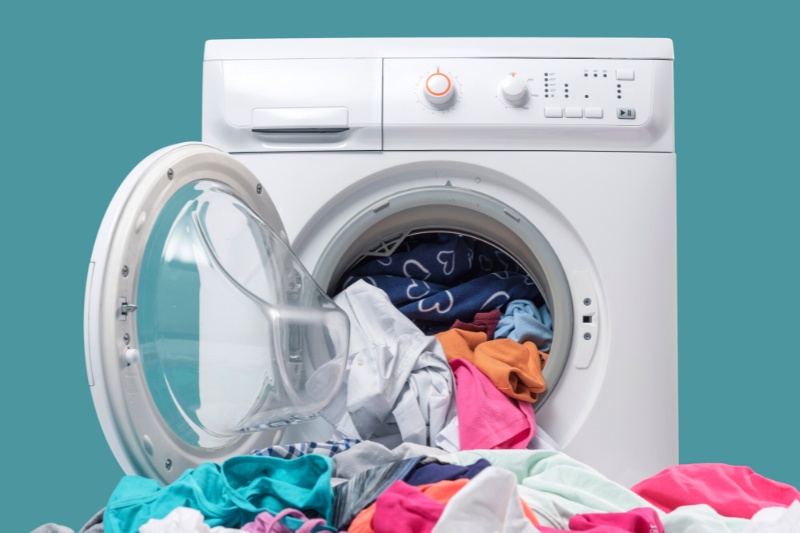
When you have a washer dryer, you’re more likely to overload it with laundry during the drying phase because you’ll have forgotten that the dryer’s load capacity is different to the washers.
This isn’t ideal because overloading (and underloading in some cases) a washer dryer can put a strain on the inner workings of the machine, and in turn, this can encourage faults. Which, as you might’ve guessed, will be costly to repair.
4. If one part of your washer dryer breaks, you may not be able to use the whole machine
On the topic of broken parts, if one section of your washer dryer breaks, you may not be able to use the whole machine until you get it repaired.
This can, as you might’ve guessed, be really inconvenient because you’ll have to find other ways of washing and drying your clothes in the meantime.
However, it’s worth pointing out that, in most cases, if the dryer part breaks, you can continue using the washing machine side of the appliance. (But it doesn’t always work the other way around).
But even if you’ve still got a working washing machine, you’ll still have to find a way of drying your laundry, which can be quite a tiring chore to carry out!
5. Washer dryers don’t always dry clothes effectively
Washer dryers tend to come with sensors that help them decide how long the machine will take to dry clothes. However, the machine will sometimes over or under-estimate the drying times.
So, you’ll either end up with damp, patchy clothes, or the machine will run for too long and will rack up your bills in the process.
6. Washer dryers can be poor rinsers
Washer dryers aren’t always the best at rinsing detergent off clothes. This means you’ll need to run laundry through an additional rinse to clear the off residue.
It’s not necessarily a big problem, but it does mean extra work, time and cost! It is, however, worth noting, particularly if you live with someone with a skin condition whereby the detergent residue could aggravate their skin problem.
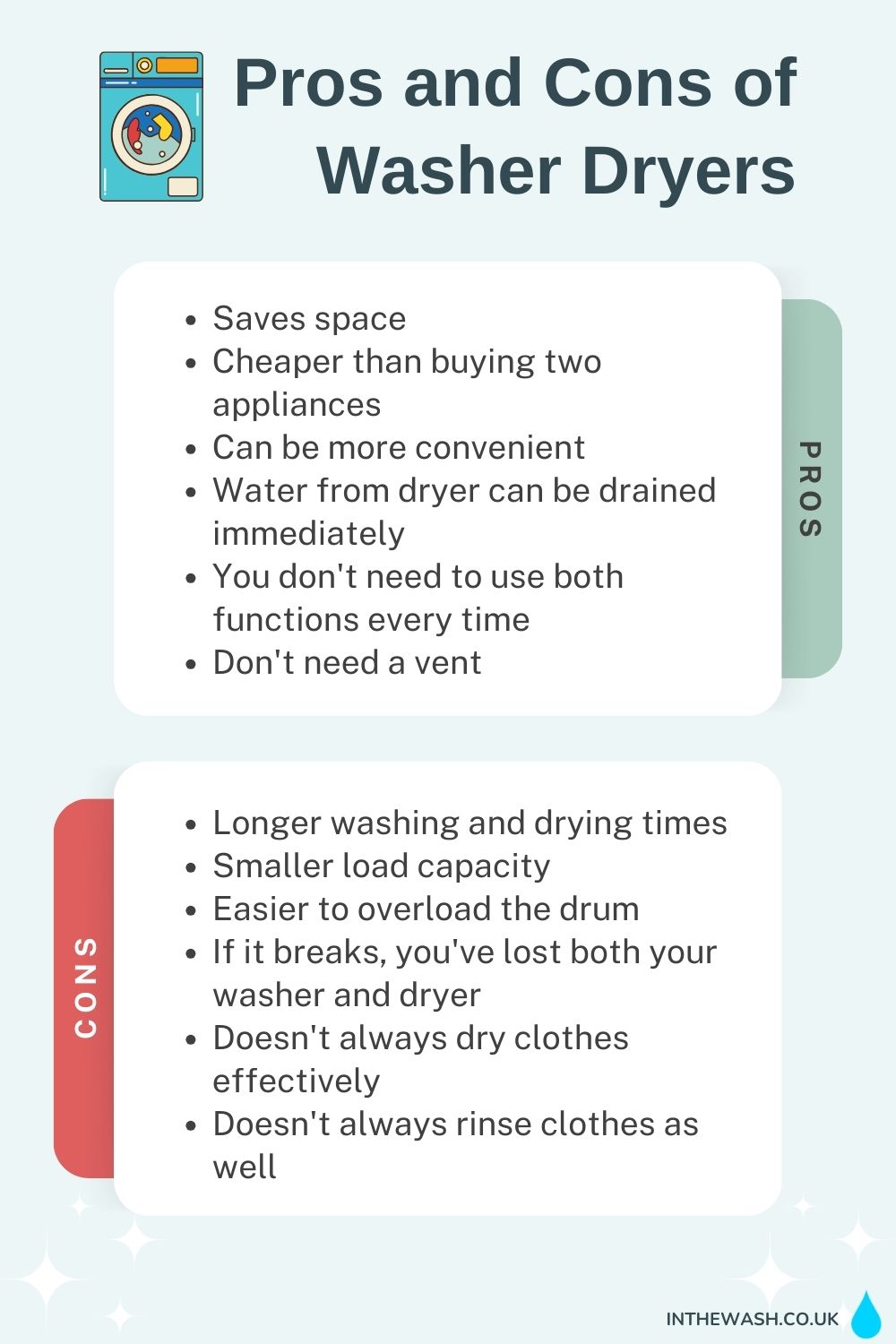
Pros and Cons of Separate Appliances
The benefits of getting separate appliances
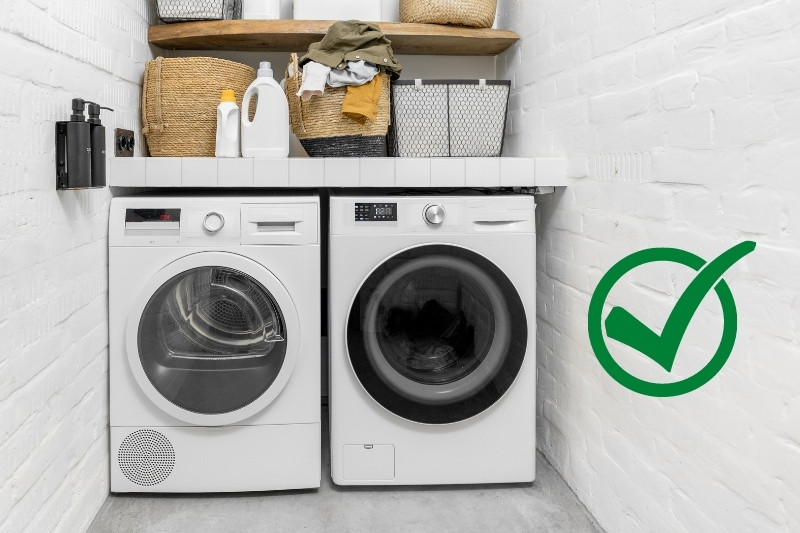
Here are the main pros of getting a separate washing machine and a tumble dryer:
1. You can use both appliances as and when you need to
By having two appliances at home, you’ll be able to wash and dry laundry at the same time. Overall, this will save you time!
2. Two appliances are better for busy homes
As mentioned earlier, if you have two appliances on the go at once in your home, you can manage your washing needs far better, which is excellent if you have a busy family and lots of laundry to wash.
3. If one appliance breaks, the other machine should still work
Another benefit of getting two separate appliances is that you know if one machine breaks, the other one will still work.
It’s highly unlikely that both a washing machine and a tumble dryer will break at exactly the same time.
4. You’ll be able to wash and dry similar amounts of laundry using two appliances
A huge bonus of getting separate appliances is that you can buy machines with the same load capacities. You can then wash and dry roughly the same amount of laundry in each appliance.
You don’t have to leave wet washing hanging around. You can pop the load in the dryer and start an appropriate cycle.
5. The specialist appliances can excel at what they do best
A washing machine and a tumble dryer are separate machines that serve different purposes.
By keeping the machines as standalone appliances, you can leave each piece of equipment to carry out the tasks they were designed to do – to clean or dry your clothes.
You can choose appropriate cycles, utilise the special features, and really make the most of each machine! In turn, you’ll get a better washing and drying experience from the machines.
Manufacturers have to make some compromises when designing washer dryers that offer both washing and drying. Separate appliances tend to be better at their jobs as manufacturers can focus on making them great at just one thing.
The drawbacks of getting separate appliances
Here are the main cons of getting a washing machine and a tumble dryer:
1. It’s costly to buy two separate appliances
The biggest drawback with getting a separate washing machine and tumble dryer is that they tend to cost more.
That being said, you don’t have to purchase two of the most expensive appliances on the market. You could buy an expensive washer that comes with all the features you like and a cheaper tumble dryer that doesn’t hit your wallet so hard!
2. You need plenty of room for a separate washer and a tumble dryer
Another issue with getting two appliances is that you need to be able to store both machines safely in your home.
You can, of course, stack appliances on top of one another, but you need the right kit and tools to do this properly. This, of course, does mean extra costs, which must be considered. Also, lifting appliances on top of each other isn’t the easiest of jobs, so you’d have to get help!
In addition, you can look into storing your appliances in separate parts of the house. However, this doesn’t always make sense from a practical point of view because you’ll be carrying wet laundry through your home, which is inconvenient and tiring.
Further to this, you’ll have to think about any additional plumbing or vents that may be required. And you’ll have to ensure they’re in place before you get your appliances.
If you cannot find a suitable place to house a washing machine and a tumble dryer, you should look into other ways of washing and drying clothes (in particular). In the end, you may realise that getting a washer dryer is the best option for you.
3. There’s more work involved with two appliances
It’s not a deal breaker, but if you have separate appliances, you’ll obviously have to move your wet laundry from the washing machine and into the tumble dryer.
Plus, you’ll have to empty a condenser dryer’s tank (if you’ve got one), which can be tedious work.
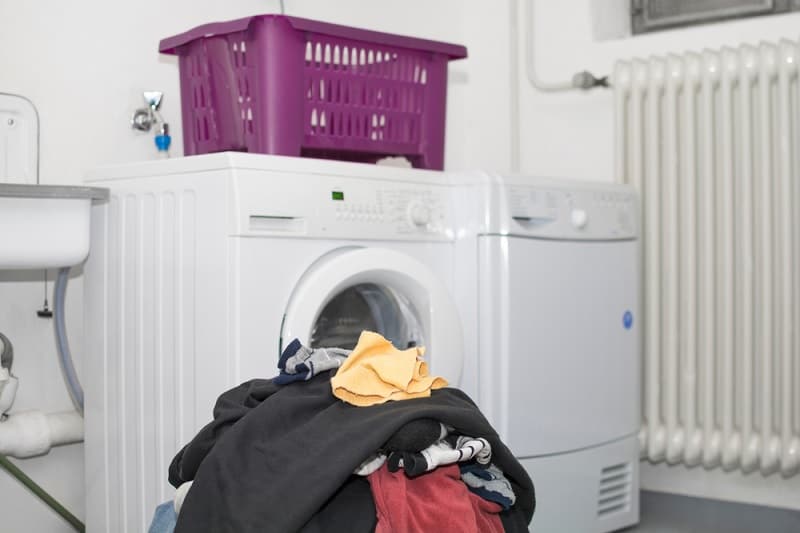
So, What’s the Verdict?
Washer dryers can be cheaper to buy, are great if you’re short on space, are easy to use, and can normally be used as two separate appliances if need be.
They are, however, a few drawbacks. Namely, they’re not always the quickest machines to use, they can use a lot of water, you won’t be able to dry all your wet clothes at once, and there are more parts inside the machine that can break down. Which, in turn, can lead to costly repairs.
On the flipside, washing machines and tumble dryers are specialised appliances that can be used to wash and dry wet clothes at speed, they’re great for busy homes, and you don’t have to worry too much if one appliance stops working.
Of course, getting two machines does have its cons, including the expense involved with buying the appliances, and you need lots of room in a home.
The verdict:
If you’re short on space, don’t do much washing per week, and you’re on a tight budget, a washer dryer is a great option for you to look into.
If you do a lot of washing per week and you need a quick turnaround with your laundry loads, you’d like to have machines with specialised washing and drying features, and you’ve got plenty of room to house two large items, it’s better to buy separate appliances.
In general, if you can afford it and have space, it’s better to have a separate washing machine and tumble dryer. You could also look into the option of using a heated airer or drying pod instead of a tumble dryer.


Bethan has a passion for exploring, reading, cooking and gardening! When she’s not creating culinary delights for her family, she’s concocting potions to keep her house clean!
